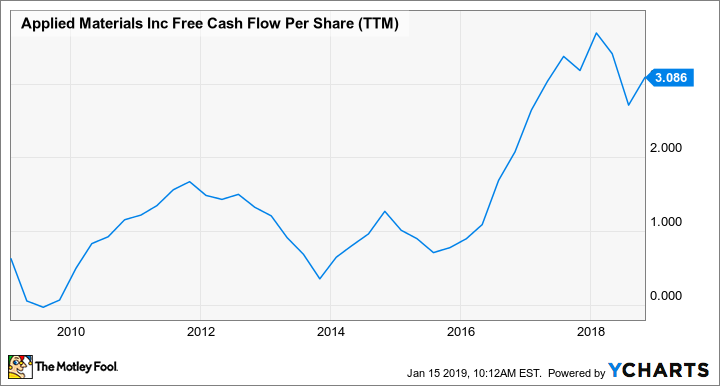Why Applied Materials Should Raise Its Dividend in 2019
Shares of semiconductor equipment manufacturer Applied Materials (NASDAQ: AMAT) tumbled more than 38% over the course of 2018. That decline came as memory chip pricing fell significantly during the second half of 2018, which forced memory manufacturers -- Applied Materials' customers -- to scale back their capital expenditure (capex) plans, meaning lower-than-expected revenue for Applied Materials.
While no dividend payment is going to be able to make up for such a large decline in the share price, a significant and growing dividend can be an important factor for many long-term investors, especially investors crafting a portfolio to generate income for retirement.

Image source: Applied Materials.
Applied Materials doesn't have a consistent history of raising its dividend at an annual clip. Indeed, before the company boosted its quarterly dividend to $0.20 per share for the payment that it made on June 14, 2018, the chip equipment giant had paid a quarterly dividend of just $0.10 for 20 straight quarters.
If the company were to stick to that playbook, it won't increase its dividend again for another four years or so. I don't think that's acceptable.
Not only do I think that Applied Materials should raise its dividend sooner than that, I think the company would do well by its shareholders to boost it in 2019. Here's why.
A sign of strength
If we look at Applied Materials' free cash flow generation over the last decade or so, it's clear why the company resisted boosting its dividend for so long.
AMAT Free Cash Flow Per Share (TTM) data by YCharts.
For a long time, Applied Materials' free cash flow per share bounced around in a relatively narrow range. On top of that, the company's previous quarterly dividend of $0.10 per share actually represented a fairly significant portion of the free cash flow that the company generated within a given year. (Although it was a larger portion in some years than in others.)
However, Applied Materials' free cash flow per share broke out between 2016 and 2018, reaching new multiyear highs. It's not surprising, then, that the company was able to double its dividend once it became clear that the company's financial performance dramatically improved.
According to CEO Gary Dickerson on the company's most recent earnings call, "... our long-term perspective on major technology trends is unchanged. Fundamental growth drivers are firmly in place as more industries are becoming increasingly dependent on technology, data, and specifically silicon to define their futures."
While these are certainly nice words I tend to subscribe to the notion that actions speak louder than words.
If Applied Materials is confident that it can continue to produce at least its current level of free cash flow (although the goal should be to continue to grow it), then a dividend increase in 2019 would make perfect sense. The current dividend of $0.80 per share on an annualized basis represents just under 26% of the company's trailing-12-month free cash flow. Applied Materials should quite easily be able to afford a decent dividend boost without constraining itself. Although even a token increase -- like $0.01 per quarter -- would be better than nothing.
More From The Motley Fool
Ashraf Eassa has no position in any of the stocks mentioned. The Motley Fool has no position in any of the stocks mentioned. The Motley Fool has a disclosure policy.

 Yahoo Finance
Yahoo Finance 
